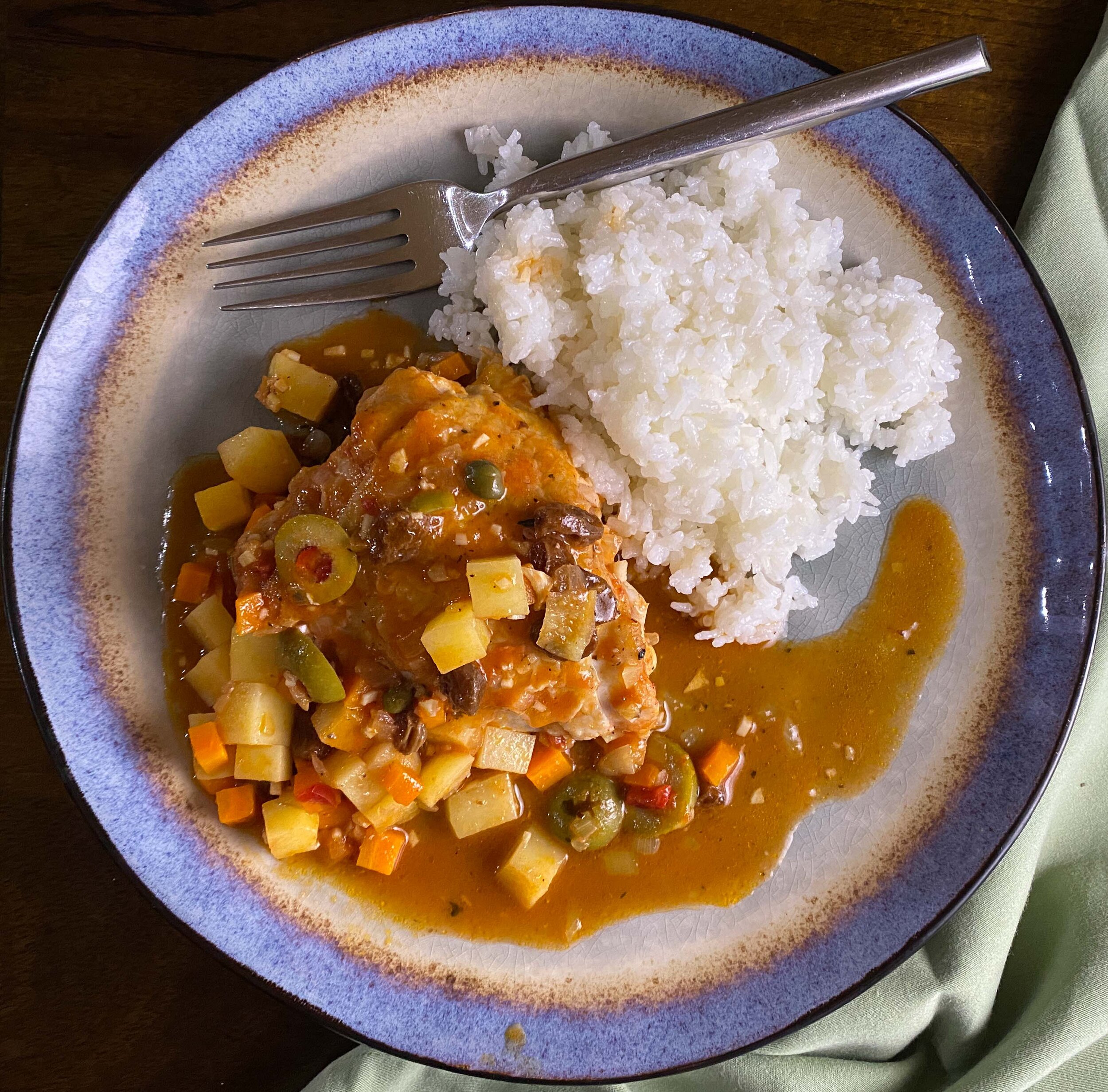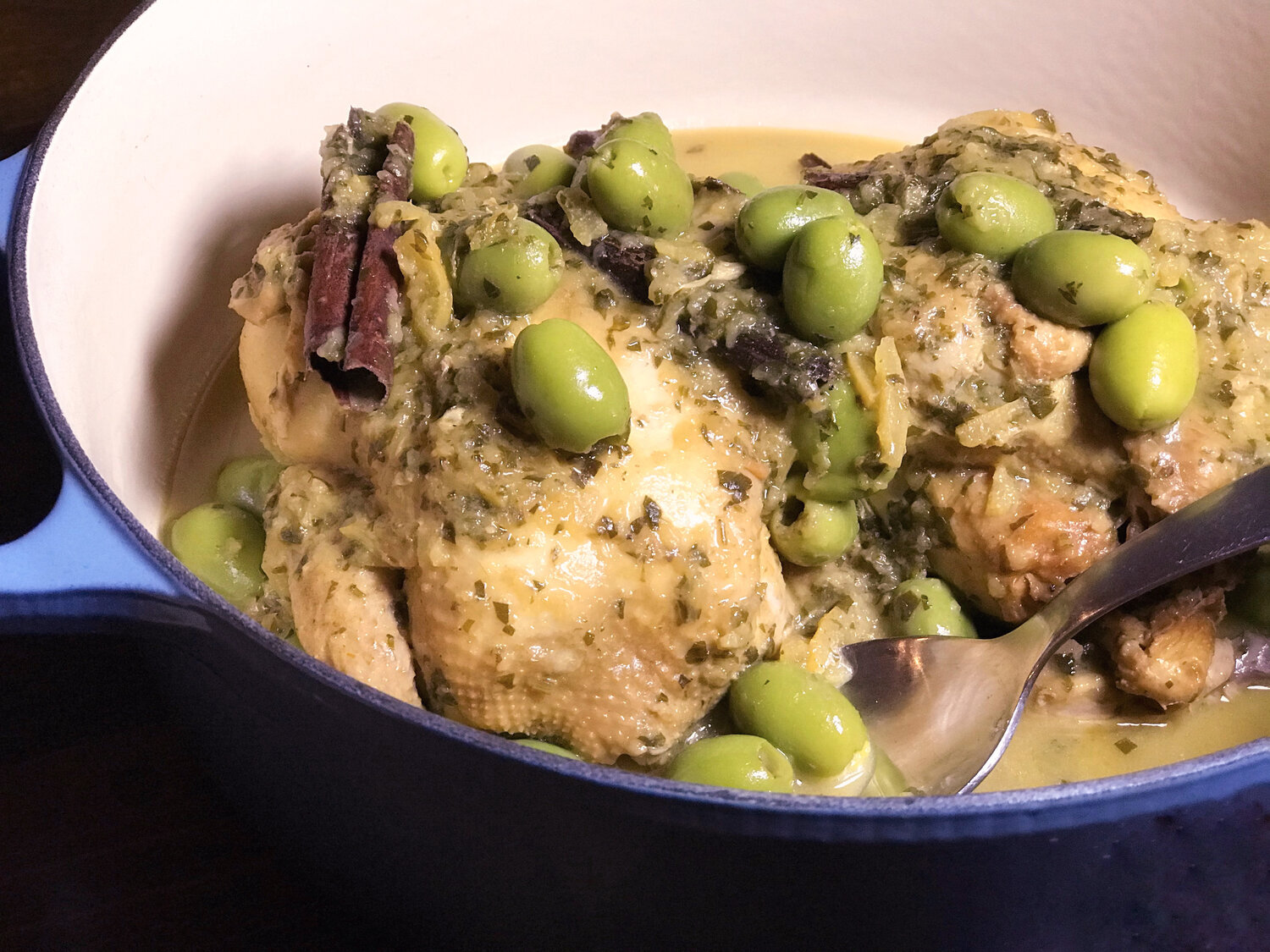Rice Noodle Salad Bowl with scallop sashimi and crab
Yep, cooking really saved us in 2020, the worst year ever. We lost ourselves — and found our sanity and our joy — in the kitchen.
So many delicious dishes came out of it that we know we’ll be cooking for years to come. Here’s the story we we ran down the first 12. And now, onto the festivities!
13. Mely Martínez’s Pollo a la Veracruzana
Because cookbook author and blogger Mely Martínez spent good chunks of her childhood learning to cook with her grandmother in Veracruz, Mexico, her Pollo a la Veracruzana was the first dish we cooked from her new cookbook, The Mexican Home Kitchen. We reviewed the book in September.
Why we love to cook it: With olives, capers, raisins and marjoram, this dish may sound a bit odd — but its flavors dance together beautifully. It’s quick and easy enough for a weeknight dinner, yet impressive enough for a special dinner for friends (if we can ever do that again!)
Fun factor: 3
14. Moroccan Chicken Tagine with Olives and Preserved Lemons
This delicious tagine came from Anissa Helou’s marvelous and monumental book Feast: Food of the Islamic World. Partly because Cornish hens were nowhere to be found when I reviewed the book in early pandemic, I adapted it for chicken.
Why we love cooking it: It teaches us so much about tagine technique, in which you only brown the meat at the end, after the meat has cooked and most of the braising liquid has evaporated. Thanks to a lot of finely grated onion and spices that melt over the course of the cooking time, it becomes a savory, silky blanket of a sauce. The dish’s high fun factor is because of the delightfulness of the technique and the beautiful aromas that result from the spices.
Fun factor: 7
15. Moussaka for the Ages
Our recipe for Greece’s most famous dish was my family’s unanimous favorite out of maybe nine jillion dishes that came out of our kitchen this year. (For my husband Thierry, it was tied with a dish that appears near the end of this list.) It was also a reader favorite: Though we only published it a week ago, it’s already among the most clicked-on of the year.
Why we love cooking it: It’s fun the first time, making the layers (potatoes, then eggplant, then lamb sauce). And the lamb sauce, spiced with cinnamon, allspice and more, fills the kitchen with a beautiful aroma. And then the “wow” moment when you see that incredible thick layer of yogurt-béchamel baked to puffy, toasty golden-brown: It’s breathtaking. Another plus: Once you make it a two or three times, it becomes second nature, because each step is quite easy. Did we mention that unlike convention versions, this one doesn’t require frying?
Fun factor: 7
16. Olivia Lopez’s Aguachile, Colima-Style
In a story in May, we featured a glorious aguachile — raw shrimp bathed briefly in chile-spiked citrus and then sauced — from Dallas chef Olivia Lopez. We made it many times in the summer, and will make it again next time we’re overcome with longing for a Mexican beach getaway.
Why we love cooking it: It’s quick, easy and transporting.
Fun factor: 3.
17. Ottolenghi’s Puy Lentils and Eggplant
I had a hard time deciding whether to include this recipe or Yotam Ottolenghi’s recipe for Stuffed Zucchini with Pine Nut Salsa. Both are included in Ottolenghi Simple, for which we are long-overdue on a review. I’ve cooked the zucchini many times — and no doubt will many more. But I can’t stop thinking about the lentils, a glorious, delicious mess of a dish. Think I’ll make it this coming Meatless Monday.
Why we love cooking it: The method is easy and soothing, and the result wholesome and delicious.
Fun factor: 4
18. Papa Ed’s Shrimp and Grits
The shrimp and grits recipe in chef Marcus Samuelsson’s new cookbook The Rise makes the best version of the dish I’ve ever had. Yes, literally. The recipe honors Ed Brumfield, executive chef of Red Rooster, Samuelsson’s restaurant in Harlem. It’s so good I won’t wait for okra season to make it again; I’ll buy frozen okra.
Why we love to cook it: In less than an hour you can have it on the table. There’s a zen-like quiet loveliness in small-dicing all the veg, and the okra are beautiful cut that way.
Fun factor: 2. The fun is in eating this one, which would be a fun factor 10!
19. Rice Noodle Salad Bowls with XYZ Skewers
A Rice Noodle Salad Bowl with grilled pork skewers adapted from Andrea Nguyen’s ‘Vietnamese Food Any Day’
Mostly over the summer, we riffed on this fabulous recipe, adapted from Andrea Nguyen’s Vietnamese Food Any Day, maybe seven or eight times. Our adapted recipe mentions “XYZ” skewers because the skewers could be just about anything — grilled chicken, grilled shrimp, grilled pork (as shown here), or even not-skewers, like the sashimi shown in our story’s lede photo.
Why we love cooking it: Because it’s infinitely riffable, super-fun to assemble and thanks to the nuoc cham, insanely delicious.
Fun factor: 9
20. Sonoko Sakai’s Okonomiyaki
After years of searching for a great okonomiyaki recipe, I finally hit the jackpot in Sonoko Sakai’s Japanese Home Cooking, which we reviewed in June. Okonomiyaki, in case you’re unfamiliar, is a savory pancake (this one is filled with cabbage and shrimp) brushed with tonkatsu sauce and topped with bonito flakes.
Why we love cooking it: “Okonomiyaki” means “as you like it,” and it’s infinitely riffable once you know the technique. Forming the pancakes and cooking them is satisfying, and it’s meant to be shared right away. We enjoyed taking turns making the pancakes (the recipe makes 4 fat ones).
Fun factor: 10
21. Salaryman Potato Salad
In the summer, potato salad became our drug of choice, and Japanese versions felt especially captivating. In a July story (remember picnic season?!), we featured one we love from Dallas Japanese ramen house Salaryman, where chef Justin Holt topped it with ajitama eggs, ramen-style. Holt has since closed the restaurant because he has been battling an aggressive form of leukemia (here is a GoFundMe to help with his mounting expenses).
Why we love cooking it: The ajitama egg, such a brilliant flourish, feels magical to make.
22. Shrimp, Sausage and Okra Gumbo
In the scanty-offerings-on-grocery-shelves days of early pandemic, I found okra, shrimp and andouille sausage at the supermarket all at the same time, and happened to have a package of dried shrimp in my larder, so I improvised a gumbo. It was deliciously soothing — both to make and to eat. I made it again, and again, tweaking until it was just where I wanted it. It’s also great to riff on according to what you have on hand. Okra season is finished, but you can skip it or use frozen.
Why we love cooking it: The power of transformation is intoxicating — shrimp shells into fabulous broth, flour and oil into a mocha-colored roux, and then the two combining into a saucy broth.
23. Tom Kha Kai
I can’t think of a better way to enjoy the sunny flavors of Thailand on a cold winter day than diving into a bowl of Tom Kha Kai, coconut-galangal chicken soup. This one is from Leela Punyaratabandu’s excellent primer, Simple Thai Food (a must-have for anyone new to Thai cooking who wants to explore).
Why we love cooking it: The aromas are absolutely transporting, it’s super easy to make (once you collect the ingredients) and the result is thrilling in its Thai-ness. Cutting fresh makrut lime leaves into strips is maximum kitchen fun — what a perfume!
Fun factor: 8
24. World Butter Chicken
To commemorate the first-ever World Butter Chicken Day, marking the 100th anniversary in October of the restaurant in India where butter chicken (murgh makhani) was invented, we developed a new, streamlined version of earth’s most popular Indian dish. Our first version was adapted from one by Monish Gujral — grandson of the chef who invented the dish. This version takes a couple hours of marination time out of the equation, with equally delicious results. Until Moussaka for the Ages came along, it was my husband Thierry’s favorite thing we’ve cooked during The Great Confinement, and he requests it again and again. (Now it is tied with Moussaka for his favorite.)
Why we love cooking it: I love the tandoori hack for the chicken, and the sauce is soothing to make, with fabulous aromatics.
Fun factor: 6
25. Yangzhou Fried Rice
If I weren’t on a serious mission to eat whole grains rather than white ones, I’d make the Yangzhou Fried Rice from Fuchsia Dunlop’s splendid book Every Grain of Rice every week or two — it’s that good.
Why we love cooking it: Making it the first time is a delicious lesson in Chinese fried rice technique, and Dunlop provides guidance on how to improve according to the ingredients in your fridge.
Fun factor: 7



















